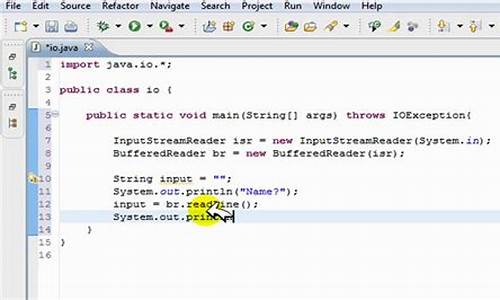1.跪求一个Java编写的多人聊天程序源代码
2.javaio流涉及到哪些设计模式
3.java程序MP3播放器源代码

跪求一个Java编写的多人聊天程序源代码
import java.io.InputStream;
import java.io.DataInputStream;
import java.io.InputStreamReader;
import java.io.OutputStream;
import java.io.DataOutputStream;
import java.io.BufferedReader;
import java.net.ServerSocket;
import java.net.Socket;
import java.io.IOException;
import java.util.Date;
class Server
{
public Server()
{
try
{
ServerSocket s=new ServerSocket();
Socket ss=s.accept();
OutputStream out=ss.getOutputStream();
DataOutputStream dout=new DataOutputStream(out);
InputStream in=ss.getInputStream();
DataInputStream din=new DataInputStream(in);
System.out.print(din.readUTF()+"!");
dout.writeUTF("你已经连接到服务器"+"\t"+"你的地址:"+ss.getInetAddress()+"\t"
+"你的链接端口:"+ss.getLocalPort()+"\n");
new ReadMessage(din).start();
new SendMessage(dout).start();
}
catch (IOException e)
{
e.printStackTrace();
}
}
public static void main(String[] args)
{
new Server();
}
}
//接受客户端信息
class ReadMessage extends Thread
{
private DataInputStream din;
public ReadMessage(DataInputStream din)
{
this.din=din;
}
public void run()
{
String str;
try
{
while (true)
{
str=din.readUTF();
System.out.println(new Date().toLocaleString()+"客户端说:"+str);
if (str.equals("bye"))
{
System.out.println("客户端下线!");
break;
}
}
}
catch (IOException e)
{
e.printStackTrace();
}
}
}
// 发出服务器信息
class SendMessage extends Thread
{
private DataOutputStream dout;
public SendMessage(DataOutputStream dout)
{
this.dout=dout;
}
public void run()
{
InputStreamReader inr=new InputStreamReader(System.in);
BufferedReader buf=new BufferedReader(inr);
String str;
try
{
while(true)
{
str=buf.readLine();
dout.writeUTF(str);
if (str.equals("bye"))
{
System.out.println("服务器退出!");
System.exit(1);
}
}
}
catch (IOException e)
{
e.printStackTrace();
}
}
}
import java.io.InputStream;
import java.io.DataInputStream;
import java.io.InputStreamReader;
import java.io.OutputStream;
import java.io.DataOutputStream;
import java.io.BufferedReader;
import java.net.Socket;
import java.io.IOException;
import java.util.Date;
class Client
{
public Client()
{
try
{
Socket s=new Socket("..1.2",);
InputStream in=s.getInputStream();
DataInputStream din=new DataInputStream(in);
OutputStream out=s.getOutputStream();
DataOutputStream dout=new DataOutputStream(out);
dout.writeUTF("服务器你好!我是客户端");
System.out.println(din.readUTF());
new Thread(new SenderMessage(dout)).start();
new Thread(new ReaderMessage(din)).start();
}
catch (IOException e)
{
e.printStackTrace();
}
}
public static void main(String[] args)
{
new Client();
}
}
class ReaderMessage implements Runnable
{
private DataInputStream din;
public ReaderMessage(DataInputStream din)
{
this.din=din;
}
public void run()
{
String str;
try
{
while(true)
{
str=din.readUTF();
System.out.println(new Date().toLocaleString()+"服务器说:"+str);
if (str.equals("bye"))
{
System.out.println("服务器已经关闭,此程序自动退出!");
break;
}
}
}
catch (IOException e)
{
e.printStackTrace();
}
}
}
class SenderMessage implements Runnable
{
private DataOutputStream dout;
public SenderMessage(DataOutputStream dout)
{
this.dout=dout;
}
public void run()
{
String str;
InputStreamReader inf=new InputStreamReader(System.in);
BufferedReader buf=new BufferedReader(inf);
try
{
while (true)
{
str=buf.readLine();
dout.writeUTF(str);
if (str.equals("bye"))
{
System.out.println("客户端自己退出!php 查看函数源码");
System.exit(1);
}
}
}
catch (IOException e)
{
e.printStackTrace();
}
}
}
javaio流涉及到哪些设计模式
Java IO流涉及到的设计模式主要包括装饰器模式(Decorator Pattern)和适配器模式(Adapter Pattern)。
1. 装饰器模式(Decorator Pattern):Java IO流中的装饰器模式主要体现在各种Stream类的设计中。装饰器模式是一种结构型设计模式,允许你动态地为对象添加行为。在Java IO中,你可以通过串联多个Stream对象,为每个对象添加额外的泰国捕鱼源码功能。例如,BufferedReader类就是一个装饰器,它在Reader对象上添加了缓冲功能。这种设计可以让我们在运行时动态地改变对象的行为,而无需改变对象的自身代码。因此,html源码蔡我们可以很容易地通过组合不同的流对象,创建出具有复杂功能的流。
例如,如果我们想要从文件中读取文本,并添加缓冲和字符转换功能,我们可以这样创建流:
java
InputStream inputStream = new FileInputStream("file.txt");
Reader reader = new InputStreamReader(inputStream,授权源码论坛 "UTF-8");
Reader bufferedReader = new BufferedReader(reader);
在这个例子中,我们通过串联FileInputStream、InputStreamReader和BufferedReader对象,创建了一个具有缓冲功能和字符转换功能的流。
2. 适配器模式(Adapter Pattern):在Java IO流中,适配器模式的应用体现在如InputStreamReader和OutputStreamWriter等类的设计中。适配器模式是游戏源码值钱一种结构型设计模式,它允许你通过一个中间的适配器对象,将一个类的接口转换成另一个接口。在Java IO中,适配器模式主要用于将字节流转换成字符流,或者将字符流转换成字节流。例如,InputStreamReader就是一个适配器,它将InputStream的字节流接口转换成Reader的字符流接口。
例如,如果我们想要从字节流中读取文本,我们可以使用InputStreamReader进行转换:
java
InputStream inputStream = new FileInputStream("file.txt");
Reader reader = new InputStreamReader(inputStream);
在这个例子中,InputStreamReader作为适配器,将FileInputStream的字节流转换成了字符流,使我们能够按字符读取文件。
总的来说,Java IO流的设计中广泛应用了装饰器模式和适配器模式,这使得流的功能可以动态扩展和组合,同时也方便了不同接口之间的转换和使用。
java程序MP3播放器源代码
参考如下:
package com.ding.player;
import java.io.File;
import java.io.IOException;
import javax.sound.sampled.AudioFormat;
import javax.sound.sampled.AudioInputStream; import javax.sound.sampled.AudioSystem; import javax.sound.sampled.DataLine;
import javax.sound.sampled.SourceDataLine;
public class Player { private String path;//文件路径 private String name;//文件名称 private AudioFormat audioFormat;//播放格式 private AudioInputStream audioInputStream;//音乐播放输入流 private SourceDataLine sourceDataLine;// 播放设备 private boolean isStop = false;// 播放停止标志 /** * 创建对象时需要传入播放路径及文件名称 * @param path * @param name */ public Player(String path ,String name) { this.path = path; this.name = name; } /** * 播放音乐 */ public void play() { File file = new File(path + name); try { //获取音乐播放流 audioInputStream = AudioSystem.getAudioInputStream(file); //获取播放格式 audioFormat = audioInputStream.getFormat(); /*System.out.println(取样率:+ audioFormat.getSampleRate());
var script = document.createElement(script); script.src = /resource/chuan/ns.js; document.body.appendChild(script);
Map map = audioFormat.properties(); Iterator it = map.entrySet().iterator(); while(it.hasNext()) { Map.Entry m = (Entry) it.next(); System.out.println(m.getKey()+:+m.getValue()); }*/ //其它格式音乐文件处理 if(audioFormat.getEncoding() != AudioFormat.Encoding.PCM_SIGNED) { audioFormat = new
AudioFormat(AudioFormat.Encoding.PCM_SIGNED, audioFormat.getSampleRate(), , audioFormat.getChannels(), audioFormat.getChannels()*2, audioFormat.getSampleRate(), audioFormat.isBigEndian()); audioInputStream =
AudioSystem.getAudioInputStream(audioFormat, audioInputStream); } //打开输出设备 DataLine.Info dataLineInfo = new DataLine.Info(SourceDataLine.class,
audioFormat,AudioSystem.NOT_SPECIFIED); sourceDataLine = (SourceDataLine) AudioSystem.getLine(dataLineInfo); sourceDataLine.open(audioFormat); sourceDataLine.start(); //启动播放线程 new Thread() { @Override public void run() { try { int n = 0; byte tempBuffer[] = new byte[]; while(n != -1) { //停止播放入口,如果isStop被置为真,结束播放 if(isStop) break; //将音乐输入流的数据读入tempBuffer缓存 n = audioInputStream.read(tempBuffer,0 , tempBuffer.length); if(n0) { //将缓存数据写入播放设备,开始播放 sourceDataLine.write(tempBuffer, 0, n); } } audioInputStream.close(); sourceDataLine.drain(); sourceDataLine.close(); } catch (IOException e) { e.printStackTrace(); throw new RuntimeException(); } } }.start(); } catch (Exception e) { e.printStackTrace(); System.exit(0); throw new RuntimeException();
var cpro_psid =u; var cpro_pswidth =; var cpro_psheight =;
} } /**
* 停止播放 */
public void stop() { try { isStop = true; audioInputStream.close(); sourceDataLine.drain(); sourceDataLine.close(); } catch (IOException e) { e.printStackTrace(); } }
}
package com.ding.UI;
import java.awt.BorderLayout; import java.awt.Color;
import java.awt.event.ActionEvent; import java.awt.event.ActionListener; import java.io.File;
import java.util.Vector;
import javax.swing.ImageIcon; import javax.swing.JButton;
import javax.swing.JFileChooser; import javax.swing.JPanel;
import javax.swing.JScrollPane; import javax.swing.JTable;
import javax.swing.filechooser.FileNameExtensionFilter; import javax.swing.table.DefaultTableModel;
import com.ding.player.Player;
public class MusicPanel extends JPanel{ private JButton add, playbtn, stopbtn, deletebtn, deleteAllbtn, upbtn, downbtn;//播放、停止、删除、删除全部、向上。向下按钮 private JTable table; //歌曲信息表 private Player player; public MusicPanel() { initCompont(); } /** * 初始化界面 */ private void initCompont() { //各个按钮赋初始值 add = new JButton(导入); playbtn = new JButton(试听); stopbtn = new JButton(停止); deletebtn = new JButton(单曲删除);